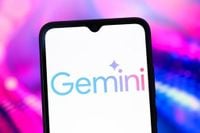Google has officially rolled out its Veo 2 video-generating AI model to subscribers of Gemini Advanced, the company's premium AI subscription service. This new feature, which began on April 15, 2025, allows users to create short video clips from text prompts, marking a significant advancement in the realm of generative media.
Veo 2 is designed to produce high-resolution, detailed videos with cinematic realism. It enables users to generate eight-second video clips at 720p resolution in a 16:9 aspect ratio. These clips can be downloaded as MP4 files or shared directly to platforms like TikTok and YouTube using the app's share button. Google emphasizes that the model has a better understanding of real-world physics and human motion, which helps deliver fluid character movement and lifelike scenes.
To create a video, users simply select Veo 2 from the model dropdown in the Gemini app and describe the scene they want to generate. The more detailed the prompt, the more control users have over the final output. For instance, one might request a wide, slow-panning shot of an enormous glacial cavern, bathed in eerie twilight, or an aerial view of a grassy cliff overlooking a sandy beach at sunset. Google encourages creativity, allowing users to explore various visual styles from realism to fantasy.
However, there are usage limitations. Google has implemented a monthly cap on the number of videos users can create, although the exact number has not been disclosed. Users will be notified as they approach this monthly limit. This is particularly important given the resource-intensive nature of video generation, which requires significantly more processing power than traditional text or image generation.
In addition to its standalone capabilities, Veo 2 is integrated with Whisk, a generative AI experiment that allows users to create new images using both text and image prompts. The Whisk Animate feature lets users transform AI-generated images into eight-second videos, further expanding the creative possibilities for Gemini users. This integration is also available to Google One AI Premium subscribers globally.
Google has taken steps to ensure a safe experience for users of Veo 2. All videos generated with this model are marked with SynthID, a digital watermark embedded in each frame to indicate that the content is AI-generated. This is part of Google's broader strategy to address concerns about the potential misuse of AI-generated media, such as disinformation and deepfakes. The company has also engaged in extensive red teaming to evaluate and improve its AI systems against possible adversarial attacks.
The introduction of Veo 2 comes at a time when competition in the AI video generation space is heating up. OpenAI recently launched its own video generation model, Sora Turbo, and other companies like Runway are making significant strides in synthetic media technologies. In fact, Runway recently raised over $300 million to further its developments in this area, underscoring the urgency for Google to enhance its offerings in the face of rising competition.
Despite the excitement surrounding Veo 2, there are growing concerns within the creative industries about the implications of such technology. A study commissioned by the Animation Guild, which represents Hollywood animators and cartoonists, estimates that over 100,000 jobs in film, television, and animation could be disrupted by AI by 2026. Many artists view AI video generators as a threat to traditional creative processes, fearing that automation could undermine the value of human artistry and craftsmanship.
Demis Hassabis, CEO of Google DeepMind, has indicated that there are larger ambitions for Veo 2 beyond its current capabilities. The company plans to integrate Veo more closely with Gemini models to enhance their understanding of the physical world, potentially leading to more sophisticated AI applications in the future.
For now, the rollout of Veo 2 is limited to Gemini Advanced subscribers, who pay $20 per month for the service. This premium model is designed to provide users with advanced features that are not available in the free version of Gemini. As the rollout continues over the coming weeks, feedback from users will be crucial in shaping the future development of Veo 2 and its integration with other Google services.
With the introduction of Veo 2, Google is not only expanding its capabilities in the AI landscape but also raising important questions about the future of creativity in an age increasingly dominated by artificial intelligence. As users begin to explore the potential of this new tool, the balance between innovation and the preservation of human artistry will be closely watched by both tech enthusiasts and creative professionals alike.










